Repurposed
Searching for a “gargoyle graveyard” — and finding an unseen corner of campus
The following essay was written for Professor John McPhee ’53’s “Creative Nonfiction” course in the spring. It has been adapted for PAW.
A few weeks back I’d been told about the myth of the “gargoyle graveyard,” a wooded area where the University stores dozens of stone gargoyles that have been removed, for one reason or another, from various Gothic buildings on campus. Adam Maloof, an associate professor of geology at Princeton, claimed to have seen the graveyard (a term he coined himself) with his own eyes, albeit several years ago. He’d even taken a gargoyle with him the last time he visited — apparently, it sits on his desk, glaring at him while he performs geological studies on its stone relatives. I was able to meet Maloof one weekday afternoon so he could take me to the site. Our travel companion (and chauffeur) was nonfiction writer John McPhee — also an expert on geology since writing a Pulitzer Prize-winning book on the subject — and as we climbed into his beige minivan and drove across Lake Carnegie on Washington Road, the wind began to pick up.
In a few minutes, we arrived behind the West Windsor Fields, at a gate marking the entrance to an area now designated for greenhouses. “I remember this place,” Maloof said excitedly. “There were two fenced-in areas adjacent to each other. Each area was about the size of two offices. One was filled with salvaged bikes from all over campus, and the other was filled with these gargoyles!”
A groundskeeper from Princeton University Facilities was locking up for the day. Maloof eagerly hopped out of the van and started a conversation with him. Soon enough, they came to the car window so we could hear the details over the wind. The groundskeeper’s name was Joe Mihalik, and, yes, he’d seen the gargoyles before, also many years ago. But they weren’t here anymore, he said. He wasn’t sure where they were moved to, but our best bet would be to go to the large Facilities complex on the other side of Washington Road.
And so across the street we went, to an inconspicuous turnoff at 300 Washington Road. There, behind the trees and shrubs that line the street, is an enormous maintenance yard. It’s bordered by a solar farm to the north, a large expanse of undeveloped wetlands to the south, and the railroad tracks of New Jersey Transit’s Princeton Branch to the west. The complex is comprised of four distinct inner yards and six warehouse buildings unmarked but by their lettered indicators (Bldg. A – Bldg. F). Almost all of Facilities’ major departments, from groundskeeping to architecture to masonry, have storage space on this land, and for that reason there is no place on Princeton’s campus quite as oddly exciting. It is filled with hidden treasures. We took our time driving among the hundreds of piles of various items that littered the yard — roof tiles, bricks, cinderblocks, bicycle racks, street signs, entire bus stops, as well as assemblages of shipping containers, pickup trucks, and construction machinery. Most impressive of all, to Maloof and McPhee in particular, was the yard’s immense variety of building stones. They took turns rattling off names as we passed each type: “granite,” “Belgian block,” “limestone straight from Vienna.” Meanwhile, I pointed out the things I could name, such as “pipes,” “rocks,” and “dirt.” We continued to play this game until we found someone who could provide us with more information. He was another groundskeeper, and this time I was the one who got out to speak with him. Naturally, I asked about the gargoyles, and he pointed to a spot behind three hill-sized mounds of dirt, an area that looked overgrown. That is the only place they could still be, he told me, there among the fragments of an old, broken arch.
The arch! Back by the greenhouses, as we were leaving, Mihalik had mentioned that the gargoyles might be found among the remains of an archway that was damaged by a tractor-trailer in 2003. Maloof and McPhee remembered the arch and its accident well — it was built in 1951 in honor of Princeton mathematician, professor, and dean Luther P. Eisenhart, and marked the western boundary of the University’s graduate campus. Surely we’d found the gargoyles now. I climbed back into the minivan, and we carefully meandered around the three great mounds of dirt until we reached the yard’s northern border, a line marked by a thin strip of unkempt weeds and wetlands that separates the complex from the solar farm. There, concealed under a tall cover of stem grass, rested the crumbling remnants of the upper span of the Eisenhart Arch. If we hadn’t been looking for it, we would not have noticed a thing. From a few feet away, the stone pieces (Indiana limestone, according to Maloof and McPhee) resembled concrete rubble, but a closer look from above revealed that each piece was finely carved in an intricate Gothic design and marked with a black metal tag with an identification number. If matched according to a corresponding catalogue, University Architect Dan Casey would later tell me, the upper span of the arch could be reconstructed like a jigsaw puzzle — but a lack of money and location has thus far prevented that from happening. According to Casey, other projects have taken precedence over the years, leaving the Eisenhart Arch seemingly forgotten under its forest of weeds. My disappointment over the lack of gargoyles was overshadowed by the thought that such an elaborate work of architecture had been sitting in ruin for the past 15 years. For a few minutes, the three of us walked among the building stones, brushing aside stems of grass that were attacking us in the violent wind, and paid our respects.
The West Windsor Maintenance Yard is a constantly evolving organism. Its layout transforms with each passing day as piles are added and removed. The road within the yard changes course like a river as maintenance workers in dump trucks and bulldozers rearrange new paths between the shifting heaps. Following my first encounter with the place, I returned twice more over the course of the week, and each time it looked different — but never less alive.
One such morning, on another briskly windy day, I was meandering around stacks of floor mats when I began to notice that someone in a white Facilities pickup was watching me from across the yard. I was unmistakably an outsider, wearing a bright blue backpack and poking around with a notebook, and as I got closer to his truck I was worried he’d kick me out. Instead, he gave me a big friendly wave of the hand, and I waved back. This was good. We were friends. Thinking I was in the clear, I walked past the truck towards the next yard. Then, from behind me, I heard a door open.
“You looking for somethin’?” I turned around to see my new friend, a large man in his mid-50s, leaning out the driver’s side. He was shouting over the wind.
“I’m a student working on a paper about this yard for my journalism class!” I said as I walked back towards him.
“Journalism!” he scoffed. “What are you, FOX News — that’s the Republican news, you know what they say!” This was apparently sarcasm. He laughed a deep belly laugh for a few seconds, and then took a breath. “I’m just kidding around. Hop in. What do you want to learn?”
I took him up on his offer and got into the pickup truck. He had a Styrofoam coffee mug in the cup holder; the heat was blasting inside the cabin. His name was Bill Tansley, he said, and I quickly realized that the volume of his voice did not, as I had thought, increase with the wind. He was loud all the time.
“I call this place Gallagher’s Yard,” Tansley said proudly. “That’s because Sean Gallagher knows everything there is to know about what goes on around here. Everyone’s got their own departments and areas — you’ve got the masonry there, the roofing tiles over here, the grounds guys got their stuff all over the place — everyone’s got their chunk, but at the end of the day it’s all Sean. You know Sean?”
Sean Gallagher is the director of civil engineering for Facilities Operations. On the phone with me a few days earlier, he had seemed not to want me to go into his yard at all. Whatever I was looking for, he told me, wasn’t there. This did not make much sense to me until, just before meeting Tansley, I was on my own in the yard, stepping over rusted metal and walking among heavy machinery. I chose to keep these details to myself.
“I’m part of the School of Architecture,” Tansley continued. “You seen the side of my truck? Has a number on it, ending with the letters SOA — that means School of Architecture. You can tell where all these Facilities trucks are from, that way.”
We started driving around, noticing some more of the odds and ends in storage — LED crosswalk signals, a Compost Tea Applicator, and a memorial plaque dedicated to “THE 13 PRINCETON ALUMNI WHO TRAGICALLY LOST THEIR LIVES IN THE TERRORIST ATTACKS OF SEPTEMBER 11, 2001.” Tansley pointed out all these things with the same excitement Maloof and McPhee had showed during our first visit. I asked him to please let me know if I was keeping him from his work. He shook it off completely. “In this job, nobody keeps track of me. I don’t got to punch in or nothing. As long as you do the right thing here — it’s on the honor system, and they expect you to be an adult and do your job.”He said that what he loved most was working with students like me (“You guys are great!”). Every couple of semesters, he helps teach a hands-on architecture course and works with students in the field. “When I interviewed for this job I went in and I said, ‘What I don’t know and the student don’t know, we’ll find the answer out together.’ Then the supervisor said, ‘When can you start?’ And I been here 16 years!”
“Can you see yourself staying here?” I asked.
“I see myself retiring here. Another 13 years, as long as they’ll have me. These jobs are hard to find!”
Minutes later, he told me that the only jobs that will always be available are in schools (“need ’em”), hospitals (“you gotta have doctors”), and printing (“someone’s gotta print the labels for pharmaceuticals”). That’s why, for his first “real job,” he went into printing. “When I was a kid — you’re middle class, you know, and dad’s at work and mom’s at home — I went to work with my dad, in construction. I didn’t like working with my dad much back then, I disagreed a lot with him, but it was school on the job — school as far as construction went. After that, I did printing for a few years, with a buddy of mine from back home.” Tansley grew up in Toms River, N.J., and hasn’t really left the area his entire life. He thought for a moment. “I’ve just gone from trade to trade until I ended up here.”During this discussion, we were parked by a lone American flag, which presided over a cluster of shipping containers and port-a-potties. For a rare second, the yard around us was silent. I noticed two men who were welding something in the distance. The bright green flame stood out like a star.
The silence ended abruptly when Tansley noticed that the dumpsters were free and he started driving towards them. The pickup’s engine roared. He’d been waiting for a chance to dump some wood planks from the back of his truck — that was why he was here in the first place. The Yard is remarkably sustainable considering the sheer amount of raw material that passes through it. At various points in our conversation, Tansley mentioned the different ways the Facilities department sustains itself on its own assets. The dumpsters, for example, are hardly meant for trash — they’re used to store materials, such as wood and steel, for repurposing. He introduced me to The Tumbler — a cylindrical machine that resembled a giant hamster wheel — which is used to mix and fuse stone remnants into cobblestone curb linings. “They really don’t throw nothin’ away!” Tansley said incredulously. Perhaps the best example of Facilities’ commitment to use things over again is hidden in plain sight — among the mounds of dirt that had initially concealed the location of the remains of the Eisenhart Arch. One of the mounds is so massive that it can be climbed by a bulldozer, and the driver of that bulldozer is almost always a man known as F.J.Tansley introduced me to F.J. as he drove by us at the dumpsters. The whole place might be nicknamed Gallagher’s Yard, but F.J., on the throne of his massive John Deere crawler, is the one who physically maintains every inch. The piles of dirt are all his, and he jumped at the opportunity to explain their subtle distinctions. The most massive “mountain” is where raw dirt (and everything that comes with it) is dumped after being dug up for any project. The three smaller mounds denote the three steps of processing as that dirt is converted into nutrient-rich topsoil for use around the campus. First, the raw dirt from the mountain is sifted and put into a smaller pile. Sand is mixed in to make the next pile. The final pile is an amalgamation of dirt, sand, and compost, which F.J. refers to as “some real good topsoil.”
As F.J. and Tansley proceeded to get into a very technical conversation about the enormous grade-adjustment project F.J. has had underway for several years in the yard (water runoff management is extremely important when you’ve got dirt roads), I remembered the gargoyles. Amidst the excitement of the yard itself, I’d forgotten to ask Tansley about them altogether, but if anyone knew where they were — or if they even existed — it would be F.J.
As luck would have it, F.J. did remember seeing some gargoyles once, a while back. He first suggested a masonry area I’d already examined, and then directed me to a spot he thought I surely hadn’t considered: behind his topsoil piles, near the pieces of an old arch that was hidden among weeds.
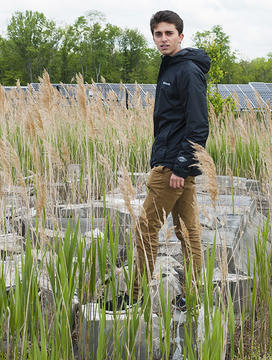


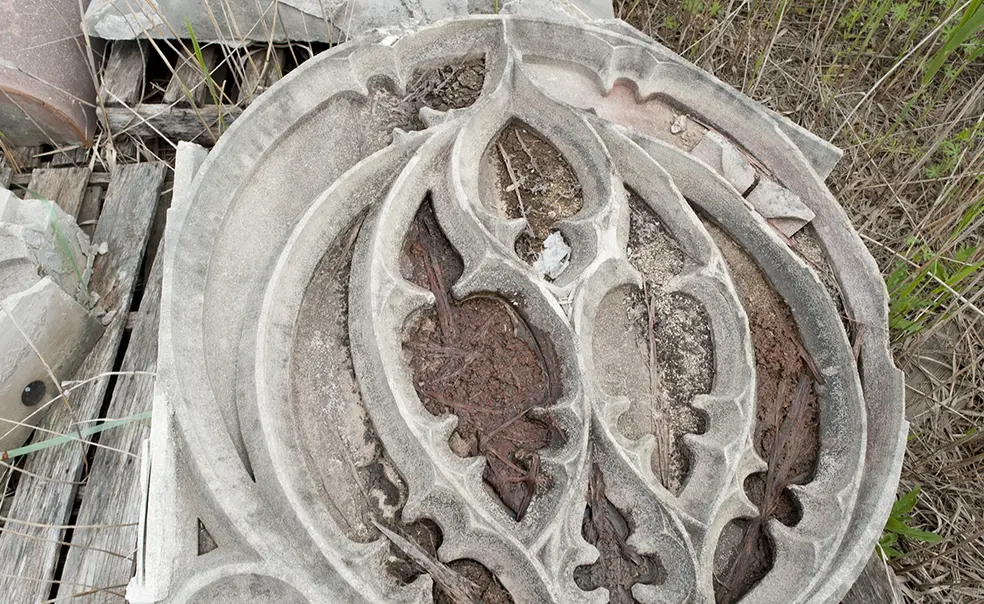
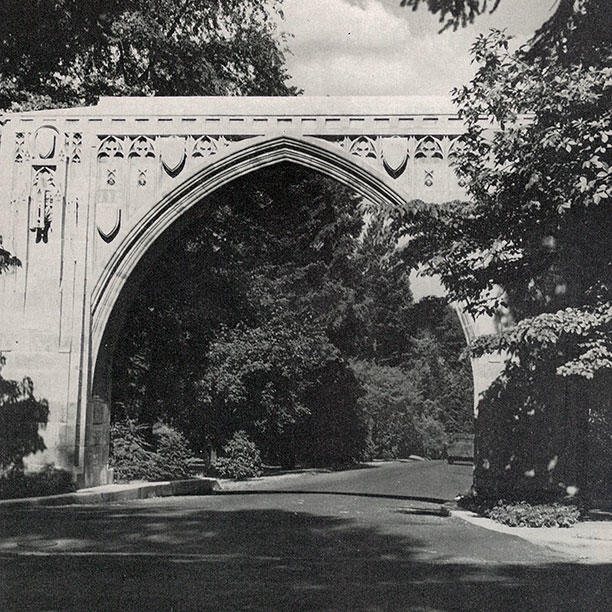

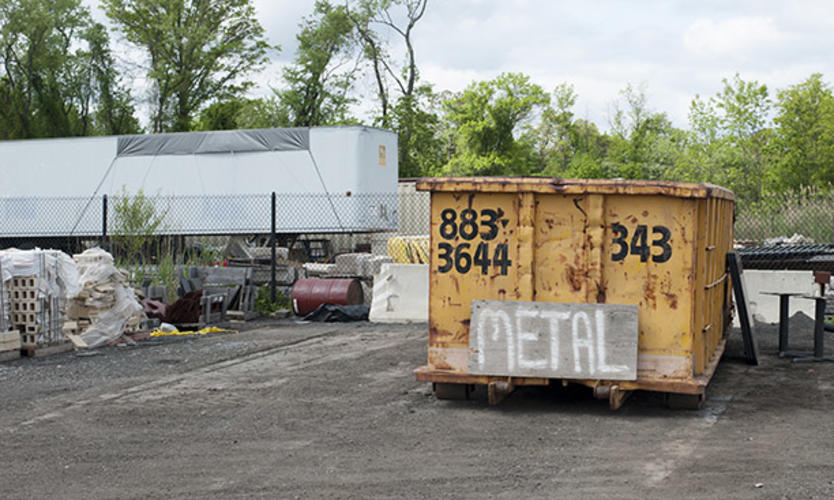
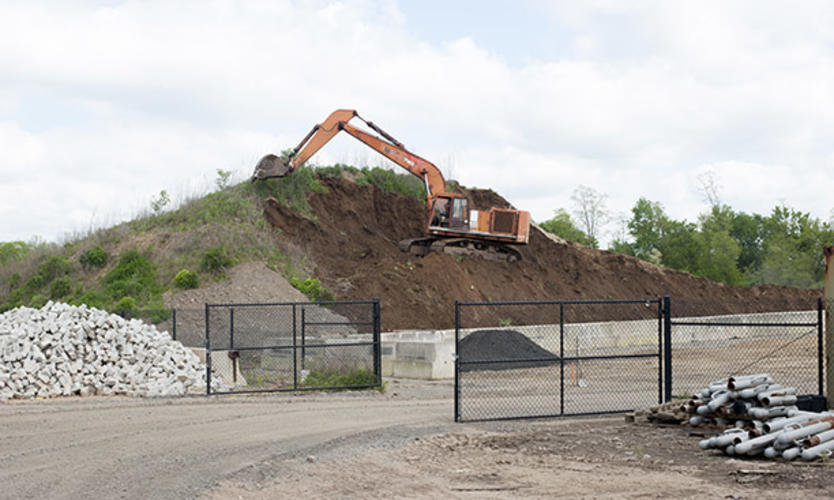









1 Response
Robert E. “Bob” Buntrock *67
8 Years AgoAbrupt ending, did you find...
Abrupt ending, did you find the gargoyles? Don't leave us in suspense!